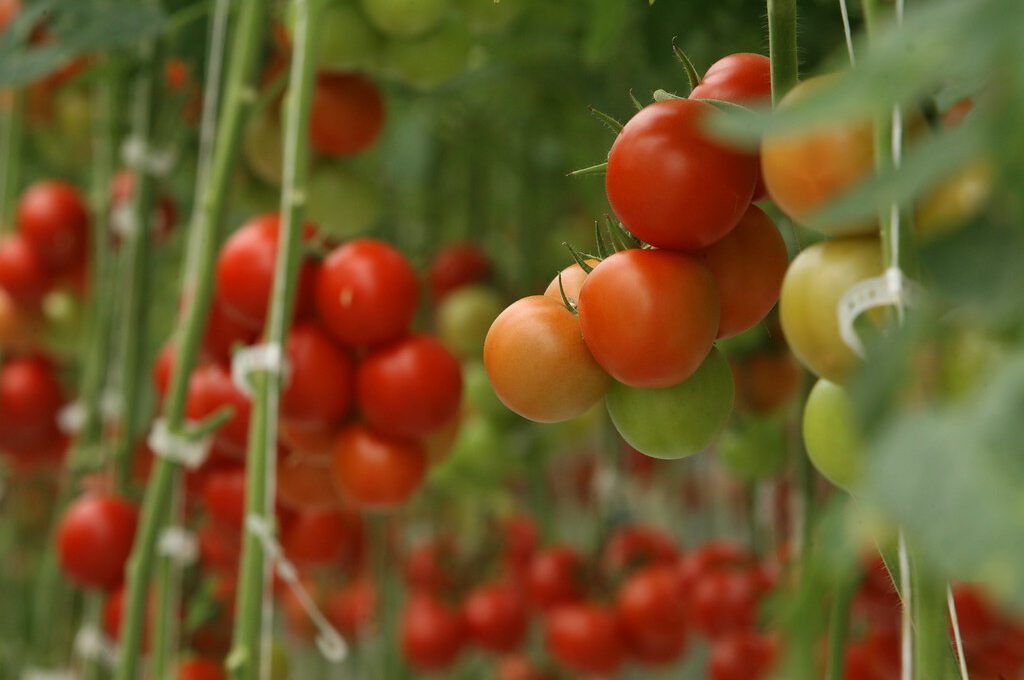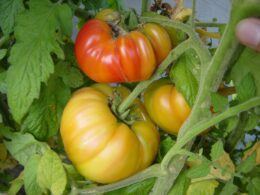Watering tomatoes correctly is important to ensure an abundant harvest.
Taking the time to understand your watering needs, water regularly and deeply, and avoid overwatering can help ensure a successful tomato crop.
Using drip irrigation and mulching, and watering at the right time of day are also important.
By monitoring your plant’s health, you can be sure you are providing the best care for your tomatoes.
With a few simple steps, you can reap the rewards of growing delicious tomatoes.
Understand Your Watering Needs
To get the best results from your tomato plants, it’s important to understand their watering needs. Tomato plants require consistent and frequent watering but not too much – you want to keep the soil moist without waterlogging them.
You’ll need to check your soil regularly for moisture levels and adjust your watering frequency accordingly. The best way to do this is with a soil moisture meter which will help you determine when it’s time to water, saving you both time and effort in the long run.
When watering tomatoes, it is important to ensure that the water reaches deep into the root zone of the plant. If only surface-level water is applied, roots will stay near the surface where temperatures are cooler and evaporation occurs more quickly – resulting in dehydration of your tomato plants.
An easy way to make sure that enough water is reaching down deep into the soil is by using a soaker hose or drip irrigation system.
Give your tomatoes a good soak every week or two depending on temperature and humidity levels in order to maintain adequate levels of soil moisture without over-watering them. Keeping an eye on both weather conditions and soil moisture content can help you achieve optimal results from your tomato plants!
Water Regularly and Deeply
Watering tomatoes deeply and regularly will help them thrive and bring you a delicious harvest! To ensure your tomato plants get the best nutrition, it’s important to water them properly. Here are five tips for watering tomatoes correctly:
- Water using rainwater whenever possible – rainwater is free of chemicals and contains essential nutrients for tomato plants.
- Monitor soil moisture levels in between waterings – check the top two inches of soil with your finger or a moisture probe to determine if they need more water.
- If necessary, use fertilizing methods – such as compost teas or liquid seaweed extracts – to give your tomatoes an extra boost.
- Water at the base of each plant instead of from overhead – this prevents leaves from getting wet which reduces the risk of diseases developing on foliage.
- Avoid over-watering – too much water can lead to root rot and other issues that can harm your plants.
Tomatoes require regular, deep watering for optimal growth and production. Remember, deep watering encourages strong roots, which are essential for healthy tomato plants!
Keep these tips in mind when caring for your tomato garden so you can reap the rewards of a tasty harvest come summertime!
Avoid Overwatering
Too much water can cause serious damage to your tomato plants, so don’t overwater them! A good rule of thumb is that tomato plants need about one inch of water per week. To achieve this, give your tomatoes a deep soak once or twice a week instead of frequent shallow watering.
It’s important to consider the soil quality and temperature when determining how much water your tomatoes need. For example, clay soil may require more frequent watering than sandier soils. Likewise, if the weather is hot and dry, you may need to increase your watering frequency.
If you’re unsure about how often and how much to water your tomatoes, reach out to other gardeners in discussion groups online or in your community for advice on proper watering techniques. With their help and guidance, you’ll be able to determine the ideal amount of water for your tomato plants’ needs based on their current environment.
By understanding basic concepts such as soil quality and temperature, and taking cues from experienced gardeners in local communities or online discussion forums, you can ensure that your tomato plants receive just enough moisture without overdoing it. This will lead them towards a healthy harvest!
Drip Irrigation and Mulching
Using drip irrigation systems and mulching are both great strategies to help you get the most out of your tomato plants. Drip irrigation systems deliver water directly to the plant’s roots, reducing water waste and ensuring that the tomatoes receive enough moisture.
Mulching helps preserve soil moisture and keep weeds at bay, making it easier for your tomatoes to thrive. Both of these techniques can be used together or separately to ensure that your tomato plants get the best possible care.
Benefits of Drip Irrigation Systems
Drip irrigation systems provide a hassle-free way to keep tomato plants hydrated, ensuring they get the water they need for optimal growth. With this method of watering, you can create weed-free zones around your tomatoes and control soil moisture levels.
This allows you to reduce water waste while also providing an efficient and reliable way to ensure your tomato plants get the right amount of hydration. The result is healthy, robust plants with improved yield due to optimized growth conditions.
Additionally, you’ll save time and energy on manual labor by automating the watering process with a drip irrigation system. You’ll be able to focus more on what matters most: harvesting delicious tomatoes!
Advantages of Mulching
Now that you know the benefits of drip irrigation systems, let’s look at another effective way to water your tomatoes – mulching.
Mulching is a great way to keep the soil around your tomato plants moist and aerated without having to worry about overwatering or underwatering. Plus, mulch helps control weeds and reduce soil erosion.
There are two main types of mulch: organic and inorganic. Organic mulches like straw or wood chips help maintain moisture in the soil while inorganic materials like stones can also be used to provide insulation. Both types have their advantages when it comes to watering tomatoes, but either one can help promote healthier growth for your plants by increasing the amount of air and water available for absorption into the soil.
Water at the Right Time of Day
You’ll want to water your tomatoes at the right time of day – early morning is best – so they can soak up all that moisture before the heat of the day sets in.
It’s important to consider soil quality and container size when deciding how often you should water your tomatoes as these factors determine how quickly the soil will dry out.
Watering too frequently or too little can have a negative effect on your crop, so it’s important to get the balance right.
For this reason, it’s recommended that you check the soil each day with your finger and only water if necessary.
If you find that your tomato plants are wilting, then increase watering frequency but be sure not to overwater.
How Much Water Do Tomato Plants Need Indoors Compared to Outdoors?
When it comes to indoor tomato garden tips, understanding the water needs of your plants is crucial. Tomato plants grown indoors generally require more frequent watering compared to outdoor ones. Since indoor environments can be drier, it’s important to closely monitor the moisture levels and adjust the watering schedule accordingly.
Monitor Your Plant’s Health
Keeping an eye on your plant’s health is key for a successful harvest, so don’t forget to check it regularly!
Monitoring the soil quality and fertilizer types used can give you insight into how well your tomatoes are growing. You can even examine the leaves of your tomato plants to get an idea of their wellbeing. If you notice any discoloration or wilting due to improper watering, then make sure to adjust accordingly.
Additionally, watch out for pests like aphids or hornworms that may be feeding on the leaves and stems of your plants; these insects can cause serious damage if they aren’t removed in time.
Taking steps now to ensure healthy growth will give you better results when it comes time to harvest!
Frequently Asked Questions
What kind of soil is best for tomatoes?
When it comes to growing tomatoes, container gardening is a great option.
To give your tomatoes the best environment, look for organic soil that has good drainage and lots of nutrients.
Look for an organic potting mix with composted manure that will enrich the soil and help keep the tomatoes strong and healthy throughout their growing season.
Make sure to water regularly but avoid overwatering – this can lead to soggy roots and disease.
With some careful watering and regular care, you’ll be rewarded with a bumper crop of delicious tomatoes!
How much water do tomatoes need?
Watering tomatoes correctly is essential for a successful harvest. Generally, tomatoes need about 1-2 inches of water per week, depending on your soil’s drainage and the frequency of watering.
To make sure you’re providing enough water, check the moisture level in the top 4-6 inches of soil by sticking your finger into it. If it’s dry, give your plants a thorough watering until the soil is moist but not soggy.
How do I know if I’m overwatering my tomatoes?
If you’re worried that you’re overwatering your tomatoes, the best way to determine the soil’s moisture level is by feeling it with your hands. If the soil is cool and moist up to two inches below its surface, then there’s no need for additional water.
If it feels dry or warm, then it’s time to water your tomatoes. To prevent overwatering in the future, you can add amendments like compost or mulch to your soil. These will help retain moisture better.
Are there any fertilizers I should use for tomatoes?
You may want to use fertilizers when caring for your tomatoes. Different types of fertilizer can provide essential nutrients to help the plants grow strong and produce delicious fruit.
Depending on the type of fertilizer you choose, you’ll need to adjust your watering frequency accordingly. Be sure to read and follow the instructions on the packaging for best results.
What kind of pests or diseases might affect my tomatoes?
Protecting your tomatoes from pests and diseases is an essential part of their care. To prevent disease, water at the base of the plant and avoid overhead irrigation. Also, keep your plants strong with regular pruning to prevent infestations.
Pest control involves identifying insects that might cause damage and using organic methods, such as hand-picking or insecticidal soaps, to get rid of them.
By following these simple steps, you can ensure that your tomatoes stay healthy all season long!
Conclusion
It’s important to understand how to water tomatoes correctly. Regular, deep watering is the key to success, but you must also avoid overwatering.
Drip irrigation and mulching can help retain moisture and keep your plants healthy. Be sure to water at the right time of day for best results.
Keep an eye on your plants’ health and adjust your watering methods as needed. With proper care, you’ll have a bountiful harvest of delicious tomatoes!









